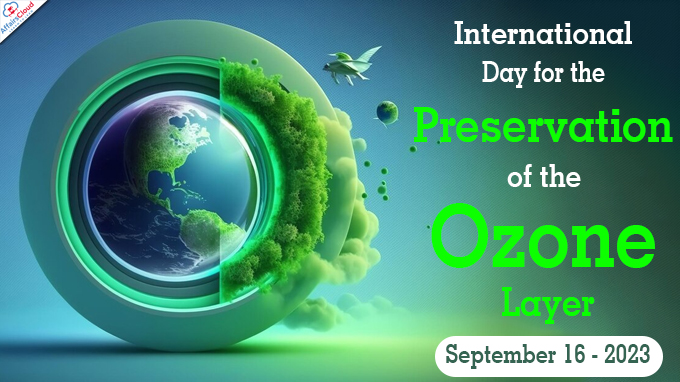 The United Nations (UN) World Ozone Day or International Day for the Preservation of the Ozone Layer is annually observed on September 16 to raise awareness about the importance of the ozone layer and its depletion that leads to global warming and climate change across the world.
The United Nations (UN) World Ozone Day or International Day for the Preservation of the Ozone Layer is annually observed on September 16 to raise awareness about the importance of the ozone layer and its depletion that leads to global warming and climate change across the world.
- The day also aims to bring attention to the significance of preserving the Ozone layer. This day is also known as “Global Ozone Day.”
The 2023 theme of the International Day for the Preservation of the Ozone Layer is, “Montreal Protocol: fixing the ozone layer and reducing climate change.”
- The theme highlights and reiterates the positive impact of the Montreal Protocol on ozone layer recovery and reducing climate change.
Note: The theme also emphasises the Kigali Amendment, with its focus on the phase-down of hydrofluorocarbons (HFCs) and improved efficiency in the cooling sector, brings significant climate mitigation benefits.
Background:
i.On 19 December 1994, the United Nations General Assembly (UNGA) adopted a resolution A/RES/49/114 and proclaimed September 16 as International Day for the Preservation of the Ozone Layer.
ii.The first International Day for the Preservation of the Ozone Layer was observed on 16 September 1995.
Why September 16?
The date September 16 commemorates the date of the signing of the Montreal Protocol on Substances that Deplete the Ozone Layer with a resolution A/RES/49/114 in 1987.
About Ozone:
i.Ozone (O3) is a highly reactive colourless gas composed of three oxygen atoms. It is both a natural and a man-made product that occurs in the Earth’s upper atmosphere (the stratosphere) and lower atmosphere (the troposphere).
ii.The ozone in the stratosphere, known as the “ozone layer,” a fragile shield of gas, protects the Earth from the harmful portion of the rays of the sun, thus helping preserve life on the planet.
iii.Approximately 90% of atmospheric ozone is located in the stratosphere, which begins about 10–16 kilometers above the Earth’s surface and extends upwards to about 50 kilometers.
Few important conventions related to Ozone layer protection:
Montreal Protocol:
i.The Montreal Protocol, is a landmark multilateral environmental agreement that regulates the production and consumption of nearly 100 man-made chemicals referred to as ozone-depleting substances (ODS)
- ODS are substances that are commonly used in products such as refrigerators, air conditioners, fire extinguishers, and aerosols.
ii.The Montreal Protocol was signed by all the 198 UN Member states, the only UN treaty ever that has been ratified by every country on Earth.
Vienna Convention for the Protection of the Ozone Layer:
i.In 1985, the world’s governments adopted the Vienna Convention for the Protection of the Ozone Layer, which entered into force in 1988.
ii.The convention aimed to promote cooperation among 28 signatory countries that agreed to research and monitor the effects of human activities on the ozone layer and to take concrete action against activities that are likely to have adverse effects on the ozone layer.
Note: On 16 September 2009, the Vienna Convention and the Montreal Protocol became the first treaties in the history of the UN to achieve universal ratification.
Kigali Amendment:
On 15 October 2016, the Parties to the Montreal Protocol on Substances that Deplete the Ozone Layer reached an agreement to phase down hydrofluorocarbons (HFCs), at their 28th Meeting of the Parties, in Kigali, Rwanda.
Significance:
i.As per the Scientific Assessment of Ozone Depletion: 2022 report from the Scientific Assessment Panel (SAP) to the Montreal Protocol confirmed that ozone layer recovery is on track and ozone levels are expected to return to 1980 levels by around 2066 over the Antarctic.
ii.A successful HFCs phasedown (global implementation of the Kigali Amendment) is expected to avoid up to 0.5 degrees Celsius of global warming rise by 2100 while continuing to protect the ozone layer.
iii.With the implementation of the Montreal Protocol, up to 2 million cases of skin cancer may be prevented globally each year by 2030.
iv.In June 2023, the first World Meteorological Organization (WMO) Ozone and UV Bulletin showed that the production and consumption of controlled ODS have been phased out up to 99%.




